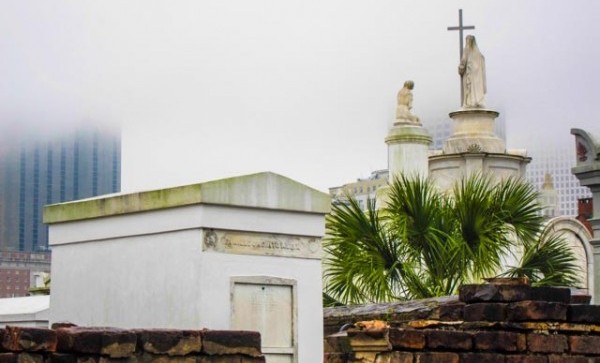
As of March 1, you’ll need to shell out some cash if you want to see the tombs of St. Louis #1 Cemetery, the most iconic burying ground in New Orleans. This is a big change, as the cemetery has been free and open to visitors since 1789. After nearly a quarter-millennium of uncontrolled access, you now need a guide registered with the Archdiocese of New Orleans. That guide, in turn, has to pay as much as $5,400 a year for the right to usher people through the gates.
Even if you’ve never been to the city, you may know about this cemetery from countless travel stories. Located a short walk from the French Quarter, this major tourist draw has the look of a crowded if somewhat rundown subdivision of mini-temples—some vaguely Egyptian, some Greco-Roman. The deceased are traditionally interred in an upper chamber (called “the oven”), and after a year and a day, the coffin is pulled out and the remains emptied into a lower chamber, thereby mingling with the bones of predeceased family members. It’s sensible and space-saving. Also, according to visitors I’ve overheard, it’s gross.
You might also know the cemetery from the scene in the 1969 landmark movie Easy Rider where Peter Fonda (“Captain America”) and Dennis Hopper take an acid trip and have sex with a pair of hookers. The scene was filmed on the run, without permits or permission. Once the archdiocese saw it, Easy Rider became the last film to be shot in St. Louis #1.
Still, other untoward things have been happening without permission lately, and that’s why it’s now gated off to the unchaperoned public.
The main attraction—the equivalent of an anchor store at a mall—is what’s purportedly the tomb of Marie Laveau, said to be one of the great voodoo priestesses of the 19th century. Little agreement exists as to her powers, or whether she’s simply been confused with a later imposter who took her name. But no matter. Over time, certain “local traditions” grew up around this tomb—visitors were supposed to scratch three “X”s on it with a brick broken off other tombs, spin around three times, and leave a few coins or some personal memento as tribute. Sometimes this illicit activity was encouraged by fly-by-night tour operators focusing on the dark arts. The tomb and other nearby tombs—called “Faux Levaus”—became a mess of “X”s. Parts of the cemetery began to look like Times Square of yore.
This was offensive to the Glapion family, whose tomb it is, and apparently to the person who snuck in early last year and gave the tomb a misguided makeover, painting it a Pepto-Bismol pink. Restorers were brought in to strip off the latex paint, then replaster it. The whole episode made the tomb even more of a sideshow destination.
Speaking of sideshows, allow me to introduce into the narrative the actor Nicholas Cage. In 2010, he acquired a plot not far from Marie Laveau’s and had a large, severe concrete pyramid built on it. Supposedly, he’s planning to be interred within it upon his demise. He doesn’t speak about this publicly, and his publicist didn’t respond to an inquiry I sent last week. Still, his tomb has become another (dis)attraction; many visitors have left lipstick kisses on it. This evidently annoyed Cage, but at least the kisses are visually more appealing than the crude “X” marks. Still, according to visitors I’ve overhead, it’s gross.
That the diocese wants to put a halt to this sort of vandalism—and divert some revenue out of the pockets of private tour guides and into ongoing preservation—is both rational and understandable.
But it’s sad that for the casually curious traveler so much else is now closed off. Curbing access to the cemetery feels like closing the stacks to an entire library because some visitors were defacing the E. L. James books.
In truth, there’s a far more intriguing if less showy history in the bones interred here. Among many other long-term residents are Homer Plessy, half of the Plessy v. Ferguson Supreme Court case of 1896, which essentially legalized the doctrine of “separate but equal.” And Benjamin Latrobe, the second Architect of the U.S. Capitol and an early instigator of Greek and Roman revival architecture, may also be buried hereabouts. (That is, if his remains made the trip from an earlier cemetery, but no one’s sure). And here lies Paul Morphy, a brilliant and eccentric chess master who was the Bobby Fischer of his day.
It’s hard not to view the closure somehow as the result of the clickbaiting of history. America, of course, has of late become a colony of crows, forever snatching at shiny things on the Internet. A voodoo priestess is buried here … and you won’t believe what she did to chickens! You thought Nicholas Cage was crazy … wait ’til you hear what happens when he dies!
The more subtle, more nuanced history is now imprisoned behind a paywall, knocked out of circulation by a public uninterested in history unless it’s garish and interactive and involves celebrities. Nicholas Cage is crazy! Look at this selfie that proves it.
The virus that has infected the Internet has escaped the world of electrons. It has begun to spread through plaster and concrete. Perhaps someone should sound the alarm.

